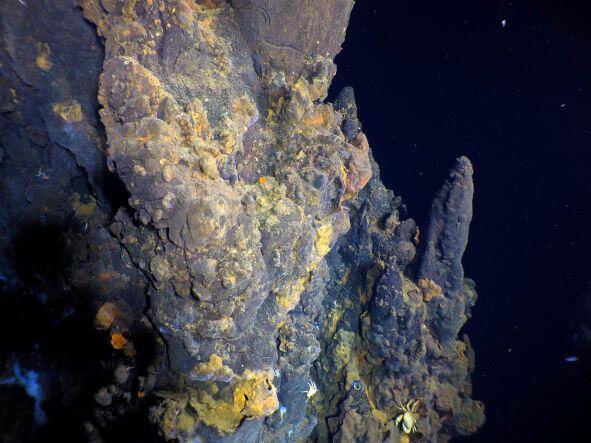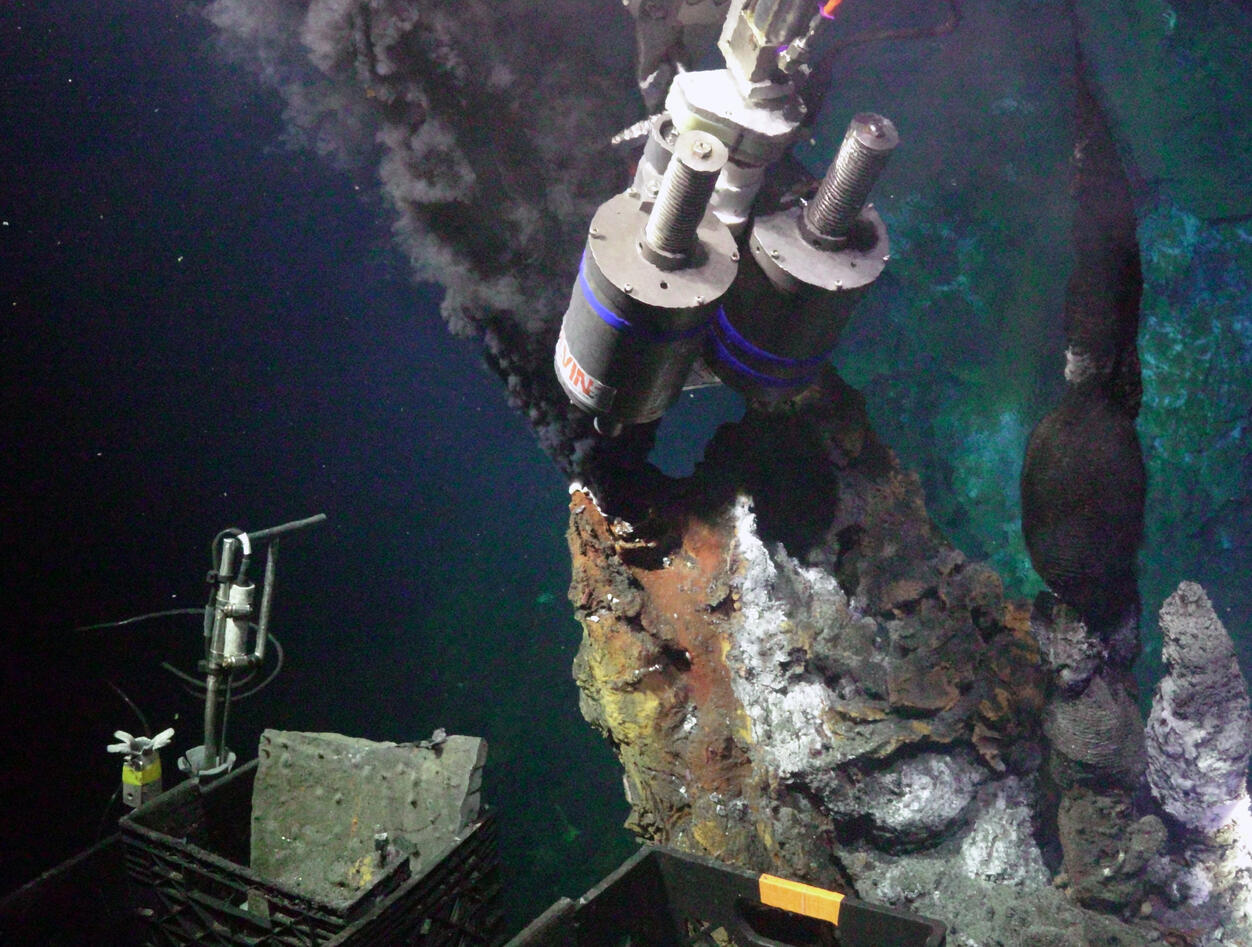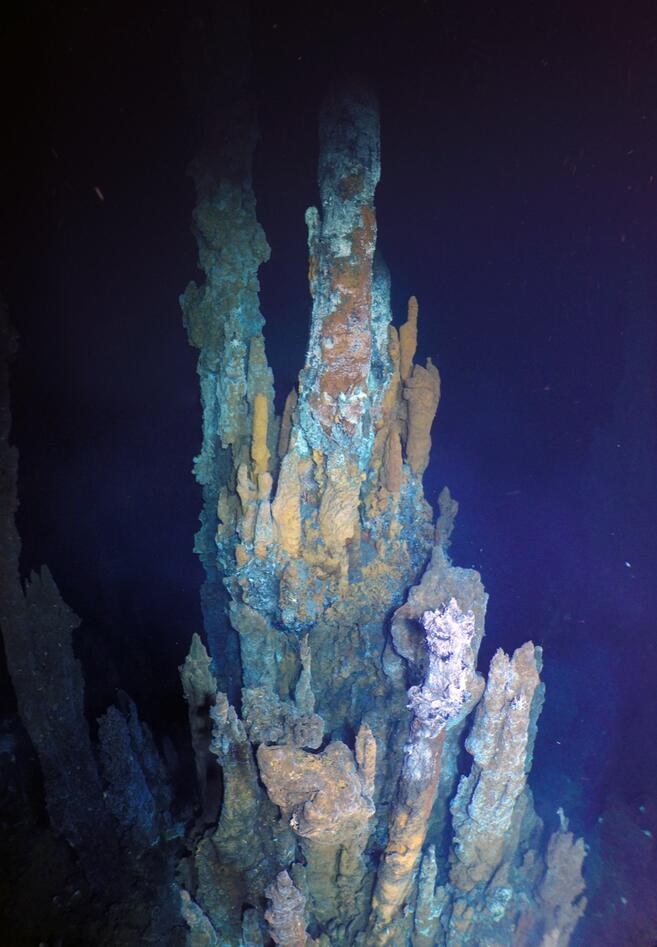New Hydrothermal Field Discovered in East Pacific Ocean
The first-known, off-axis, high-temperature deep-sea hydrothermal vents along a portion of the northern East Pacific Rise are hotter and cover more area than any other hydrothermal vents studied to date along this section of the mid-ocean ridge. The discovery demonstrates that there are more hydrothermal vents in the deep-sea than previously thought, and underscores the need for high-resolution bathymetric mapping to locate them.

Hovedinnhold
A team of researchers including Thibaut Barreyre, a geoscientist at DeepSea Centre, Department of Earth Science, University of Bergen, discovered a hydrothermal field, named YBW-Sentry, near to where the tectonic plates spread apart on the East Pacific Rise.
The discovery on the floor of the Pacific Ocean at 2,550 meters (8,370 feet) deep could change scientists’ understanding of the impact that such ocean-floor vent systems have on the life and chemistry of Earth’s oceans, the research team said.
The field is about 200 miles off the coast of western Mexico, and was discovered during an expedition on Scripps Oceanography’s research ship R/V Roger Revelle in 2021. The site of the hydrothermal vent and its field covers an area equivalent to a football field, roughly twice the size of the nearest active hydrothermal vents in the region. Vent chimneys resemble candelabras that are the height of three-story buildings.
The findings have been published today in an article entitled: “Discovery of Active Off-Axis Hydrothermal Vents at 9° 54’N East Pacific Rise,” in the journal Proceedings of the National Academy of Sciences (PNAS).
Deep-sea hydrothermal vents are found around the world, most often in volcanically active locations along the crest of the global mid-ocean ridge system. Magmatic activity, driven by upwellings of heat in Earth’s mantle, causes the brittle tectonic plates that make up Earth’s outer shell, or crust, to split. As the plates spread, new seafloor rock is formed by magmatic activity and volcanic eruptions. This magmatic and tectonic activity creates cracks through which sea water percolates in crustal rocks. Much like hot springs on land, hydrothermal vents spout mineral-rich liquid that has been heated beneath the seafloor.
The research that led to the discovery of the off-axis vent field along the East Pacific Rise was spearheaded by the McDermott lab at Lehigh University. The team collects fluids from the black smoker chimneys and analyzes them for their geochemical characteristics, which can indicate the temperatures at which the fluids are forming. Hotter temperatures could be a sign of an impending eruption. At the same time, the team also instruments the active vent chimneys with self-recording fluid temperature loggers to provide measurements every ten minutes over 2-year time periods. The temperature measurements provide a time series of the changes the vents experience. The research team has nine vents instrumented in the study area.
Near-bottom bathymetric surveys conducted by the research team between 2018 and 2021 with the autonomous underwater vehicle (AUV) Sentry, provided by Woods Hole Oceanographic Institution's (WHOI) National Deep Submergence Facility, produced the high-resolution (1 meter) maps that resolve very small seafloor features, according to Ross Parnell-Turner, a geophysicist at Scripps Institution of Oceanography in California, and a co-author of the paper.
“We identified an off-axis field of tall pinnacles, and we assumed that they were either older volcanic spires or inactive hydrothermal chimneys deposited long ago,” says Parnell-Turner.
Paper co-author Daniel J. Fornari, a marine geologist at WHOI and a co-author of the paper noted, “We were astounded that not only was the field very active, but it is larger in area and hotter in origin temperature than any other hydrothermal vent field known along this portion of the East Pacific Rise that has been studied for the past 30 years,”
According to Lehigh’s McDermott, over the past 15 years, the ways in which scientists study and sample the seafloor have been revolutionized by the high-resolution maps produced by autonomous underwater vehicles. The maps generated by the AUV sonars are similar in scale to what is used in land-based geological surveying and mapping using a variety of sophisticated techniques that include drone mapping and laser scanning.
The search for active hydrothermal vents has historically focused on the trough that marks the axis and locus of most of the volcanic eruptions along the East Pacific Rise. The team has been expanding the high-resolution map west and east of this axial trough, between 9° 45-57'N latitude, for the past three years using the NDSF's Sentry AUV.
“The mapping work provides a detailed picture of the seafloor so that we can monitor and quantify changes that occur when the next volcanic eruption happens along this portion of the East Pacific Rise ridge axis,” says McDermott.
Two previous eruptions have occurred at this site―in 1991-1992, and again in 2005-2006―and the team forecasts that the next eruption could occur within the next few years, according to Thibaut Barreyre.
“The new vent field may seed recovering hydrothermal ecosystems after volcanic eruptions,” says Santiago Herrera, a co-author who is a biological oceanographer and faculty member in Lehigh University’s Department of Biological Sciences.
The 3-year research project is funded by the US National Science Foundation's Ocean Sciences Division, Marine Geology & Geophysics Program.
Additional authors of the PNAS paper include: Connor C. Downing, Kelden Pehr and William S. Dowd in Lehigh’s Department of Earth and Environmental Sciences; Jyun-Nai Wu of Scripps Institution of Oceanography; Nicole C. Pittoors and Samuel A. Vohsen in Lehigh University’s Department of Biological Sciences; and Milena Marjanović of France’s Institut de Physique du Globe de Paris.
“There is much still left to be discovered about deep-sea vents along the global mid-ocean ridge, both in terms of where they are located as well as their geological, geochemical and biological characteristics,” says McDermott. “I hope our study will motivate future research efforts to target mapping off-axis areas along the global mid-ocean ridge crest to better quantify the extent of off-axis versus on-axis hydrothermal venting.”
Adapted from Lehigh University


